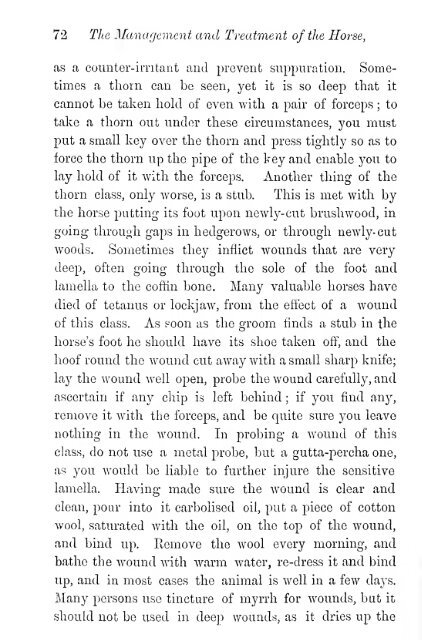The management and treatment of the horse in the stable, field, and ...
The management and treatment of the horse in the stable, field, and ...
The management and treatment of the horse in the stable, field, and ...
You also want an ePaper? Increase the reach of your titles
YUMPU automatically turns print PDFs into web optimized ePapers that Google loves.
72 <strong>The</strong> Management <strong>and</strong> Treatment <strong>of</strong> <strong>the</strong> Horse,<br />
as a counter-irritant <strong>and</strong> prevent suppuration. Some-<br />
times a thorn can be seen, yet it is so deep that it<br />
cannot be taken hold <strong>of</strong> even with a pair <strong>of</strong> forceps ; to<br />
take a thorn out under <strong>the</strong>se circumstances, you must<br />
put a small key over <strong>the</strong> thorn <strong>and</strong> press tightly so as to<br />
force <strong>the</strong> thorn up <strong>the</strong> pipe <strong>of</strong> <strong>the</strong> key <strong>and</strong> enable you to<br />
lay hold <strong>of</strong> it with <strong>the</strong> forceps. Ano<strong>the</strong>r th<strong>in</strong>g <strong>of</strong> <strong>the</strong><br />
thorn class, only worse, is a stub. This is met with by<br />
<strong>the</strong> <strong>horse</strong> putt<strong>in</strong>g its foot upon newly- cut brushwood, <strong>in</strong><br />
go<strong>in</strong>g through gaps <strong>in</strong> hedgerows, or through newly- cut<br />
woods. Sometimes <strong>the</strong>y <strong>in</strong>flict wounds that are very<br />
deep, <strong>of</strong>ten go<strong>in</strong>g through <strong>the</strong> sole <strong>of</strong> <strong>the</strong> foot <strong>and</strong><br />
lamella to <strong>the</strong> c<strong>of</strong>f<strong>in</strong> bone. Many valuable <strong>horse</strong>s have<br />
died <strong>of</strong> tetanus or lockjaw, from <strong>the</strong> effect <strong>of</strong> a wound<br />
<strong>of</strong> this class. As soon as <strong>the</strong> groom f<strong>in</strong>ds a stub <strong>in</strong> <strong>the</strong><br />
<strong>horse</strong>'s foot he should have its shoe taken <strong>of</strong>f, <strong>and</strong> <strong>the</strong><br />
ho<strong>of</strong> round <strong>the</strong> wound cut away with a small sharp knife;<br />
lay <strong>the</strong> wound well open, probe <strong>the</strong> wound carefully, <strong>and</strong><br />
ascerta<strong>in</strong> if any chip is left beh<strong>in</strong>d ; if you f<strong>in</strong>d any,<br />
remove it with <strong>the</strong> forceps, <strong>and</strong> be quite sure you leave<br />
noth<strong>in</strong>g <strong>in</strong> <strong>the</strong> wound. In prob<strong>in</strong>g a wound <strong>of</strong> this<br />
class, do not use a metal probe, but a gutta-percha one,<br />
as you would be liable to fur<strong>the</strong>r <strong>in</strong>jure <strong>the</strong> sensitive<br />
lamella. Hav<strong>in</strong>g made sure <strong>the</strong> wound is clear <strong>and</strong><br />
clean, pour <strong>in</strong>to it carboiised oil, put a piece <strong>of</strong> cotton<br />
wool, saturated with <strong>the</strong> oil, on <strong>the</strong> top <strong>of</strong> <strong>the</strong> wound,<br />
<strong>and</strong> b<strong>in</strong>d up. Remove <strong>the</strong> wool every morn<strong>in</strong>g, <strong>and</strong><br />
ba<strong>the</strong> <strong>the</strong> wound with warm water, re-dress it <strong>and</strong> b<strong>in</strong>d<br />
up, <strong>and</strong> <strong>in</strong> most cases <strong>the</strong> animal is well <strong>in</strong> a few days.<br />
Many persons use t<strong>in</strong>cture <strong>of</strong> myrrh for wounds, but it<br />
should not be used <strong>in</strong> deep wounds, as it dries up <strong>the</strong>
















